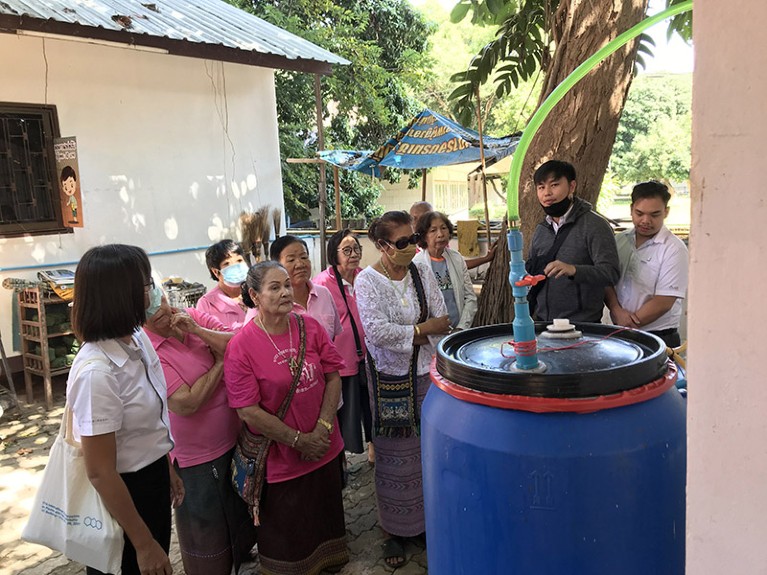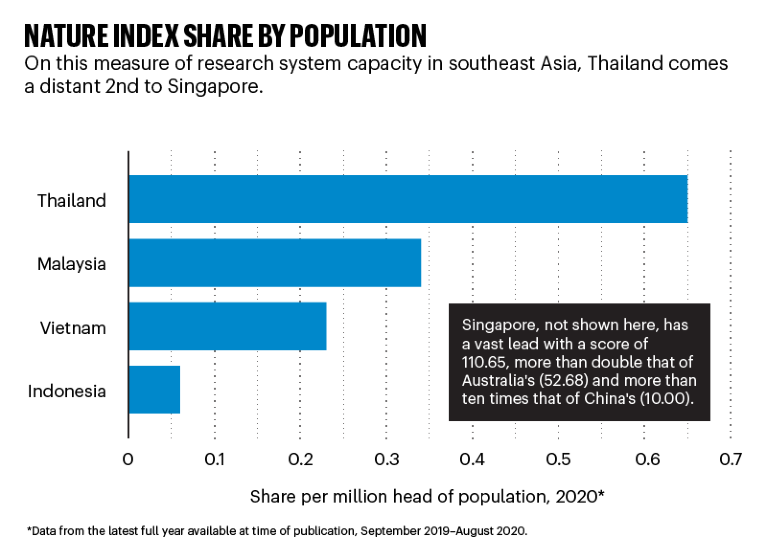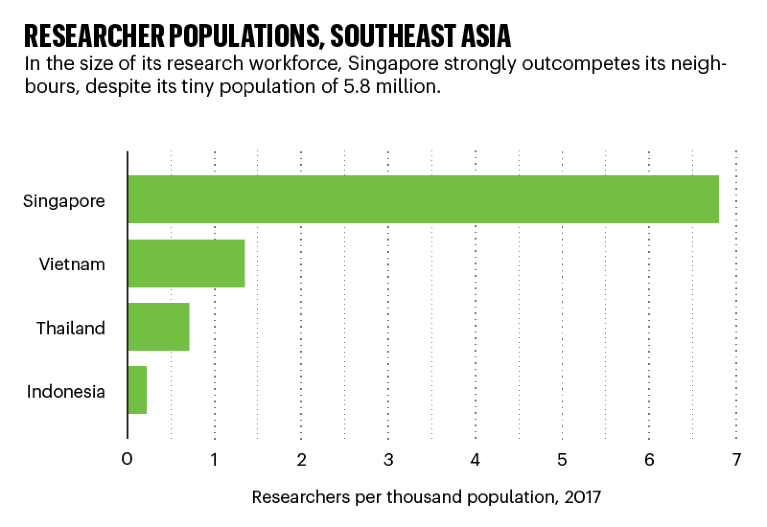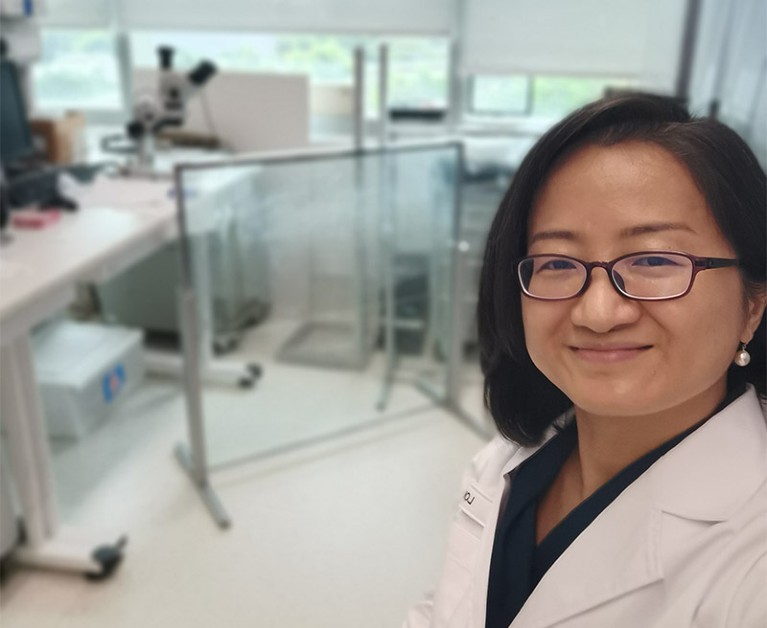
Pimchai Chaiyen (left) teaches villagers in Nan how to turn food waste into cooking gas.Credit: Panitan Thakhiew
Thanks to Pimchai Chaiyen, members of the Mahaphot community, in Nan, northern Thailand, now get value from their food scraps. In 2019, the biochemist and her team from the Vidyasirimedhi Institute of Science and Technology (VISTEC) in Rayong, installed large plastic tubs containing an anaerobic digestion system at schools, community centres and a monastery. They showed local people how microorganisms broke down the unwanted food collected in the tubs to make biogas and fertilizers.
“We wanted to create a useful tool to support the circular economy,” says Chaiyen. “Because if you don’t process food waste properly, most of it will just go to landfill, where it generates methane and carbon dioxide and contributes to global warming.”
Nature Index 2021 Asia Pacific
Chaiyen, who won the 2015 Outstanding Scientist of Thailand Award, the country’s highest scientific honour, and her institution exemplify progress in Thailand’s research. The country’s Share remains in double digits only, at 45.56 in the year to August 2020, the latest full year available. This is orders of magnitude less than China’s, at 14,450.20 for the same period. But in 2020, Thailand was third, after China and Vietnam, on Nature Index’s list of rising countries in the Asia-Pacific (APAC) region. And VISTEC, founded in 2015, is 12th in the region among the top rising non-Chinese institutions for chemistry.
From an even lower base, Indonesia and Vietnam rank fourth and fifth on the APAC rising countries list. Malaysia, with more than 2,200 researchers per million people — second only to Singapore, which has 6,730 researchers per million — had the third-highest average output in the Web of Science in south and southeast Asia in 2014–18, according to a 2019 analysis by Clarivate’s Institute for Scientific Information (ISI). The ISI report found that research output by Malaysia, Thailand and Vietnam roughly doubled in the past decade.
This may be due in part to a pivot by many universities in southeast Asia from teaching to research, in a bid to improve their international rankings and attract more funding and students. Amid growing recognition that R&D can help a country progress, governments, too, have established new ministries or policies specifically targeted at boosting research. For example, Vietnam launched its National Foundation for Science and Technology Development in 2008; Malaysia unveiled a 10-year National Higher Education Strategic Plan in 2015; and Thailand set up a new Ministry of Higher Education, Science, Research and Innovation in 2019, consolidating functions previously divided between several government entities.

Source: Nature Index, United Nations
Countries including Thailand, Vietnam and Indonesia have also introduced rules stipulating that graduate students and researchers must publish papers before they can attain their PhD or professorships. As a result, research output has increased, but not always for the better, says Numpon Mahayotsanun, an executive member of the Thai Young Scientists Academy. “It seems to me that we are being pushed to produce quantity not quality, and that publishing is linked more to recognition instead of impact.”
And although new national agendas and scientific roadmaps “look good on paper”, their execution is another matter, he says.
Updating agendas
A mechanical engineer from Khon Kaen University in northeastern Thailand, Mahayotsanun works closely with automotive, space and aerospace companies to help design processes and products. But he is often hampered by administrative red tape. “If I have to leave the university to go see a company, I have to ask my boss. And my boss has to ask his boss to sign the document,” he says. “I’ve been a professor for 11 years and I still have to do the same thing.”
Government officials seem oblivious to the need for speed in dealings with business, he says. For a company, “it’s already too late once you get the approval. The industry cannot wait for you.”
Chaiyen agrees. Currently, most of Thailand’s basic discoveries “do not go all the way” from the lab to commercialization, she says. “The government needs to be patient and persistent in supporting both basic science and technology development. They need to implement a long-term policy to focus on nurturing people and the education and research environment,” says Chaiyen. “We can definitely be supported better by the government. Sometimes we change policy too often.”
One reason for the lack of long-term R&D planning is the frequent change of ruling parties. Nations such as Indonesia, the Philippines and Vietnam, the three largest southeast Asian countries, demographically speaking, hold strong R&D potential based on the size of their populations alone, but progress is hampered by political instability.
Thailand, for instance, has had 9 changes of power in the past 20 years. “Every time a new government comes in, they have their own agenda. We shuffle a lot, then there’s a long period of downtime for our science and technology production,” says Mahayotsanun. “If you want to make good science, you need continuous support.”

Source: Nature Index, OECD, United Nations, World Bank
Sometimes, a government introduces laws that are contrary to fostering a good science ecosystem. Indonesia, for example, passed a law in 2019 that charges researchers for offences such as violating visa permits and expressing ‘unfavourable views’. This can include issuing earthquake or tsunami warnings that may create “chaos in society”, says Berry Juliandi, a biology professor at Bogor Agricultural University and former secretary-general of the Indonesian Young Academy of Sciences. As a result, “many scientists all over the world have lost interest in doing research here because they’re afraid they will be punished by criminal sanctions,” he says.
Limited investment in R&D is another probable reason why southeast Asia’s largest country hasn’t lived up to its scientific potential. “It’s got a very big population and huge resources, but looking at the data on its investment in expenditure and R&D as a percentage of GDP, it’s very low,” says Jonathan Adams, co-author of the 2019 ISI report. “Indonesia is difficult to explain in rational economic terms.”
International partnerships also play a crucial role in boosting a country’s research standing, he says. For instance, the ISI’s analysis found that Malaysia’s gross citation impact — the number of times an article is subsequently cited by later work — is 1.06, above the world average. But remove all publications with international co-authorship from the data pool, and the figure falls to 0.76.
This implies that “it is international engagement that lifts them up to the global benchmark”, says Adams. According to the ISI, Malaysia has the second-highest publication output after Singapore, at close to 12,000 papers between 2014 and 2018. But the figures suggest what is being published isn’t necessarily high-quality. “Overall, [they’re producing] lots of papers, but a large part of them are scoring poorly,” he says. Malaysia ranks 12th among the APAC countries for Share in the Nature Index.
Countries seek international collaborations partly because “world-class research is more expensive than many can afford”, says Adams. The four countries discussed here — Indonesia, Malaysia, Vietnam and Thailand — all have a high proportion of internationally collaborative articles for their article Count in the Nature Index, ranging from 90.1% for Vietnam up to 98.5% for Malaysia. Yet none has institutions represented in Nature Index’s top 100 overall collaborative partnerships within the region, which are dominated by Chinese, Singaporean, Japanese and Australian institutions. This points to comparatively low output of articles and undeveloped institution to institution ties for southeast Asian research.

Source: United Nations
“The most critical factor to increasing international publishing is cooperation with international scholars,” says Hiep-Hung Pham, who studies education policy at Phu Xuan University in central Vietnam. Because of its alliance with the Soviet Union, the country’s researchers used to avoid publishing in Western journals, he says. That changed in 2008, when the National Foundation for Science and Technology Development, Vietnam’s version of the US National Science Foundation, was established. Since then, Vietnam’s international-indexed publication volume has grown more than fivefold, according to Clarivate’s ISI records.
Pham’s research has shown that the other key factors impacting a researchers’ ability to publish internationally are sufficient support from research assistants and supervisors, as well as cooperation between domestic scholars. “Science is not something that a single person studies in their private room. It’s about connecting with people vertically and horizontally,” he says. It is also important to increase partnerships within one’s own country, says Yvonne Lim, researcher of tropical diseases at the University of Malaya in Kuala Lumpur. “We need to take a societal approach where universities work together and alongside industry partners and communities.”
Mahayotsanun agrees. Collaboration within and between countries is key to growing and progressing, he says. “I don’t think Thailand can become a [scientific] powerhouse without the support of neighbouring countries because we are attached to one another. I think the way to be powerful is to go together,” he says. “Every country has its own context, agenda and problems, but as long as we grow together, that is the key.”


 Rising tide of China’s science lifts Asia-Pacific research
Rising tide of China’s science lifts Asia-Pacific research
 Politics and the pandemic disrupt migration patterns in research
Politics and the pandemic disrupt migration patterns in research
 COVID-19 acts as a catalyst in India’s quest for self-sufficiency
COVID-19 acts as a catalyst in India’s quest for self-sufficiency
 Partnerships in progress
Partnerships in progress
 Japan and South Korea pursue shared interests
Japan and South Korea pursue shared interests








